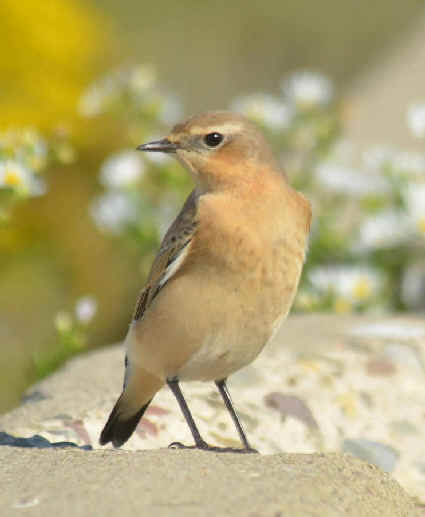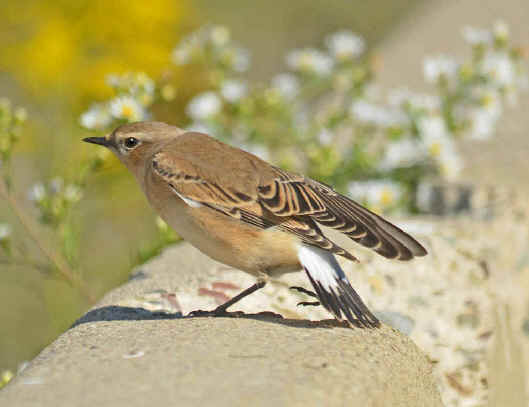The BIRDLINE, by ARMAS HILL
THE REMARKABLE WHEATEAR AND OTHER NOTABLE BIRDS
Armas Hill has presented the "Birdline", originally from
Philadelphia, on the phone and internet for over 3 decades, and on the radio
in Delaware for about 10 years.
Links:
A
List & Photo Gallery of North American Birds, in 6 Parts
A
List & Photo Gallery of North American Mammals


The Northern Wheatear in Lickdale, Pennsylvania.
In the lower photo, the "white rear".
(photographs by Howard Eskin)

The Birdline
for October 12, 2011:
This past week,
NORTHERN WHEATEARS have been seen in the eastern US in Pennsylvania
and New York.
In Pennsylvania, a single NORTHERN WHEATEAR,
was found, we understand by a birder from South Carolina, on
October 6, behind a Days Inn in a place called Lickdale, in Lebanon
County.
That bird, we also understand, had been there since
September 19. It was last seen on October 10.
There have just been a few occurrences of NORTHERN WHEATEARS in Pennsylvania.
One was collected in Montgomery County in 1919,
on October 7.
One was an unexpected find in Bucks County
on September 25, 1995, behind a photography shop
where the proprietor was a birder. So, that bird was
photographed.
One was in Juniata County, from October 4
to 7, 1997. Also photographed.
There was another one found in Lebanon County
back on October 19, 1997. That bird
was only seen for 15 minutes. Talk about "15 minutes of
fame". Conversely, the 2nd Lebanon County WHEATEAR, in
Lickdale, was seen and photographed by many.
A second WHEATEAR in Bucks County was found on October
7, 2004.
And that's it, as af as we know, in Pennsylvania.
The NORTHERN WHEATEAR in New York this past
week, was in Orange County, at the Wallkill Wildlife Management
Area, from October 7 to at least October 9.
NORTHERN WHEATEARS occur every fall along the Atlantic Coast from
eastern Canada south. This fall, so far, from September 17 to
24 on Nantucket Island, Massachusetts, on September
28 in Newfoundland, Canada, in addition to
birds in New York and Pennsylvania.
The NORTHERN WHEATEAR is really a remarkable little bird. It breeds
very far north in eastern Canada, on
frigid Baffin Island, and even further north than that! It also
breeds in Greenland, which geologically is more
"North American" than "European". The Mid-Atlantic
Rift goes through Iceland (east of
Greenland).
But most (nearly all) of the eastern Canadian breeding
WHEATEARS, and those that do so in Greenland and Iceland, migrate
south, toward Europe and then to Africa,
where they spend the winter.
The NORTHERN WHEATEAR also breeds in far-northern North America in Alaska,
and in far-northwestern Canada. Those birds migrate south,
after their breeding season, remarkably also to Africa.
They pass through Asia, going to and from, Africa. Wow.
In between eastern Canada & Greenland and far-western Canada
& Alaska, the NORTHERN WHEATEAR breeds across Eurasia,
throughout Europe and Siberia. And there's one race that breeds in Africa,
never leaving that continent.
The subspecies that nests in eastern Canada, Greenland, Iceland,
and the Faroe Islands is Oenanthe oenanthe leucorhoa.
Due to their long annual flights, these birds have developed longer
wings than the WHEATEARS that stay in mainland Eurasia and Afria.
The WHEATEARS that occur in eastern North America south of their
breeding range are O. o. leucorhoa.
The nominate subspecies, Oenanthe o. oenanthe,
ranges across Europe, Siberia, and into Alaska and far-western
Canada. They winter in northern and central Africa.
The subspecies Oenanthe oenanthe libanotica ranges from
southeastern Europe across central and southeastern Asia.
The subspecies Oenanthe oenanthe seebohmi breeds in
northwestern Africa, wintering a bit further south in
western Africa.
The English name "WHEATEAR" is as
interesting as the bird is remarkable. Actually, it's from an Old
English name going back to 1591 in a similar form, and back
to 1768 when the word "WHEATEAR" first came into
use.
As to the derivation, just replace "wheat"
with "white" and "ear"
with "rear" and you'll pretty well have
it. The white rump is a prominent field-mark of the
bird.
Photos of the Lickdale, Pennsylvania (including one showing the
white rump) are with the Birdline in the website:
www.focusonnature.com
Scroll down the
right-side of the homepage to the Birdline & Natureline.
The NORTHERN WHEATEAR is one of about 20 species of WHEATEARS. All
of the others are in the Old World.
A BIRD TRIVIA QUESTION: Noted above, the
NORTHERN WHEATEAR breeds in far-northern Canada, and also in the US
in Alaska.
I can only think, off-hand, of two species of birds that
nest in Canada, but not (normally) in
the US. What might they be?
Now, some other birds of note in the East this past week:
A MASKED BOOBY was seen offshore, in Maryland
waters, near the Baltimore Canyon on October 7.
The MASKED BOOBY is by far the rarest the 3
species of boobies that nest in the Caribbean. Nesting colonies
occur on Mona Island off the west coast of Puerto Rico, and on
small islands (cayes) off the Mexican Yucatan Peninsula. Some
nesting colonies in the Bahamas seem to have disappeared.
Also seen at sea offshore from Maryland on October 7 were 2
NORTHERN FULMARS and 160 GREAT SHEARWATERS.
The juvenile BROWN BOOBY that's been in Massachusetts
moved, this past week, from Provincetown to Barnstable.
The BROWN BOOBY that's been at Cape May, New Jersey,
has continued there.
From the West, a SAY'S PHOEBE was on Long Island,
New York, at Lloyd's Neck on October 4 & 5. Another, or
the same bird, was also seen on Long Island on October 7 at the
Robert Moses Park (field 2).
Further south, a SAY'S PHOEBE was on the Delmarva Peninsula in Virginia
on October 7, south of Exmore.
Another westerner, a BLACK-THROATED GRAY WARBLER was north of
Concord, Virginia, in Appomattox County, on October 8.
Also from the West, a LARK BUNTING was seen, this past week, near
Halifax, Massachusetts, while another LARK BUNTING
was also found in that state this past week at Gloucester.
And yet another westerner, a BELL'S VIREO was found on Assateague
Island, along the Maryland seacoast, on October 8.
It was not found on October 9.
A Selasphorus Hummingbird, from the West, probably a RUFOUS, was
in West Chester, Pennsylvania on October 10.
Another was seen in Hummelstown, Pennsylvania on October 11.
CLAY-COLORED SPARROWS have been reported this week from Maine
to Georgia. In Maine, at Cape Elizabeth.
In Georgia, at the Altamaha Wildlife Management
Area. In between, on October 8, at Sandy Hook, New
Jersey.
In Narragansett, Rhode Island lately, a
CLAY-COLORED SPARROW and a LARK SPARROW, among other
sparrows, and a DICKCISSEL have been found.
ORANGE-CROWNED WARBLERS this past week included:
2 at Sandy Hook, New Jersey, on October 8,
1 that same day at Leaser Lake in Lehigh County, Pennsylvania
and 1 at Loch Raven, Maryland on October
11.
2 AMERICAN WHITE PELICANS at Fire island, Long Island, New
York, on October 1. One was seen in flight at Cape May, New
Jersey, about a week later on October 7.
30 to 40 AMERICAN WHITE PELICANS were in flight over Sawnee
Mountain, in Georgia on October 5.
A YELLOW RAIL was flushed, twice, by a birder at the Caumsett State
Park, Long Island, New York, on October 5.
An immature PURPLE GALLINULE was seen on October 9 at Presque Isle, Erie,
Pennsylvania, between Long Pond and Big Pond, from a canoe.
That is the second record at Presque isle. The first was in October
1999.
Lately, at one pond in northern Maine, near
Caribou, a GREATER WHITE-FRONTED GOOSE was seen on October 4, a
BARNACLE GOOSE on October 5, and a CACKLING GOOSE on October 7.
GEESE have been coming south. Flocks were overhead, this
past week, further south in New England, in Massachusetts.
A RED PHALAROPE was in central New York at the
Montezuma National Wildlife Refuge on October 8 & 9.
On October 10, a RED PHALAROPE came down from the sky in
Clinton County, Pennsylvania, near a place called
Salona. It was found in a farm pasture. When found, it could not
fly, and it seemed to have a wing injury. Subsequently, it ate
worms and drank water, and seemed to be able to fly some,
before it was taken to a wildlife rehab center.
Early in the morning on October 7, in northern Chester County,
Pennsylvania, a bird fell out of the sky onto the grass next to
a woman walking her dog. It was a WHITE-THROATED SPARROW, alive, but
barely. A look above showed nothing.
Unusual in Delaware County, Pennsylvania, a NELSON'S SPARROW
was present on October 7 & 8, near Cheyney University.
In western Pennsylvania, in Crawford County, an EARED GREBE was at
Miller's Pond, still, on October 11.
A WHITE-FACED IBIS has been, this past week, in New
Jersey, at the Brigantine National Wildlife Refuge. A
female YELLOW-HEADED BLACKBIRD was still there on October 9.
Further south along the Jersey Shore, a EURASIAN WIGEON has appeared
at Cape May.
Further north along the Jersey Shore, a KING EIDER was seen at Sandy
Hook on October 8, either an immature male or an adult male in
eclipse plumage.
A LONG-EARED OWL was heard calling in the middle of the night at
Cape May Point, New Jersey, at 2:30am on October 7.
In Erie, Pennsylvania, at Presque Isle, by Lake
Erie, the prevalent bird on October 6 was the DOUBLE-CRESTED
CORMORANT, with over 1,800 tallied during a waterbird survey.
Dozens of PINE SISKINS were seen flying south at Fort Drum in
northern New York on October 5. Also: 2
WHITE-WINGED CROSSBILLS.
3 PINE SISKINS were at Cape May, New Jersey on
October 7, and 1 on October 9.
Armas Hill has presented the Birdline, originally from Philadelphia,
on the phone and internet for decades (3), and on the radio in
Delaware for years (10).
The Birdline (and the Natureline)
are affiliates of Focus On Nature Tours: www.focusonnature.com
In our website, scroll
down on the left-side of the homepage to new lists & photo
galleries of butterflies and dragonflies
& damselflies in eastern North America.
Another TRIVIA QUESTION: In which US state, is the county said
to have the most dragonfly species in one COUNTY in the COUNTRY?
To
Top of Page



